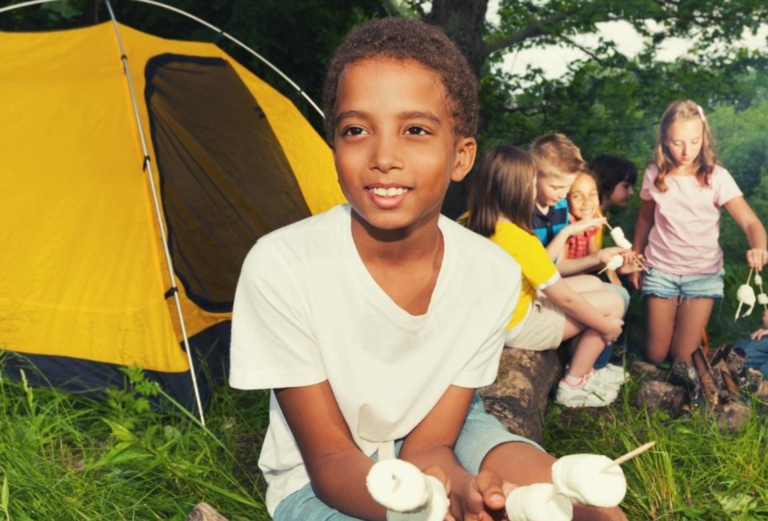Best Camping Activities For Elementary Students

Are you looking for a way to escape the confines of your daily routine and give your elementary students a taste of adventure? Camping is the perfect solution! Not only does it offer a chance to disconnect from technology and reconnect with nature, but it also provides an opportunity for valuable learning experiences. However, planning camping activities for young children can be challenging. That’s why we’ve put together a list of the best camping activities for elementary students that will keep them engaged, entertained, and excited about exploring the great outdoors.
From hiking through scenic trails to casting a fishing line in the nearby lake or river, there are plenty of exciting outdoor activities that will capture your students’ attention. And let’s not forget about one of the most beloved camping traditions – gathering around the campfire! There’s something magical about roasting marshmallows under the stars and sharing stories with friends. Whether you’re an experienced camper or new to this type of adventure, our list of top camping activities will help you make memories that your students will cherish for years to come. So pack up your gear, grab some snacks, and get ready to embark on an unforgettable journey into nature!
Hiking and Nature Walks
You’ll love exploring the great outdoors with hikes and nature walks, immersing yourself in the beauty of nature and discovering new sights and sounds along the way. These activities are perfect for elementary students who crave adventure and want to get away from the hustle and bustle of city life. Hiking allows you to experience different landscapes, from forests to mountains or beaches, while observing wildlife up close. You’ll learn about local flora and fauna, appreciate nature’s beauty, and even capture breathtaking moments through nature photography.
Nature photography is a great activity for students who enjoy capturing memories on camera. With every step you take on your hike or walk, there is always something new to photograph – from stunning landscapes to tiny insects hiding among leaves. Additionally, hiking provides opportunities for wildlife observation where you can spot deer grazing or birds flying overhead. These experiences are not only educational but also awe-inspiring as they allow children to connect with nature in a unique way. After an exciting hike or walk, it’s time to move onto another fun camping activity: fishing and water activities!
Fishing and Water Activities
If you’re camping near a lake or river, don’t forget to bring your fishing gear and take advantage of the opportunity to catch some delicious fish for dinner! Before heading out, make sure to review boating safety tips with your young campers. Teach them how to identify different types of fish and explain the importance of water conservation. This not only makes for a fun activity but also a chance to teach important life skills.
In addition to fishing, there are plenty of other water activities that can keep kids entertained for hours. Swimming is always a popular choice, but it’s crucial that all children have proper swimming skills and adult supervision at all times. Other options include kayaking, canoeing or even paddleboarding if the conditions are appropriate. Whatever you choose, just remember that water can be dangerous if not respected properly. Once you’ve had your fill of fishing and water activities, it’s time to gather around the campfire for some classic camping fun!
Campfire Activities
Gather around the crackling campfire and roast marshmallows while telling spooky stories under the starry night sky. This classic camping activity never gets old, especially for elementary students. Here are some storytelling games to make your campfire experience even more memorable:
- Round Robin: Start a story and have each person add a sentence to continue the plot.
- Campfire Telephone: Whisper a story into your neighbor’s ear, who then passes it on until it reaches the last person in the circle.
- Create Your Own Ghost Story: Have each person come up with their own spooky tale to share.
While you’re sharing stories, don’t forget about perfecting your marshmallow roasting techniques! Hold your marshmallow just above the flame, rotating it slowly until it turns golden brown on all sides. Then sandwich it between two graham crackers with a piece of chocolate for a delicious s’more.
As the fire begins to die down, transition into stargazing by laying out blankets and looking up at the twinkling night sky.
Stargazing
1) Learn about constellations and planets by pointing out different stars and identifying them using an astronomy app on your phone. Look for the Big Dipper, Orion’s Belt, and other recognizable constellations. Discuss how ancient cultures used these patterns to navigate and tell stories.
2) Develop an appreciation for the night sky by talking about how it changes throughout the year. Discuss the phases of the moon, meteor showers, and other celestial events that occur at different times. Talk about how important it is to protect our dark skies from light pollution so we can continue to enjoy these wonders.
3) Encourage curiosity and wonder by asking open-ended questions like “What do you think is beyond our galaxy?”, “How do stars form?”, or “Could there be life on other planets?”. Use a telescope or binoculars to get a closer look at celestial objects and spark even more questions. Let your imagination run wild as you explore the vastness of space together.
Learn about constellations and planets
You’ll love gazing up at the night sky and identifying constellations and planets during your camping trip. Nighttime observations are an excellent way to introduce elementary students to astronomical concepts. They will learn about the different stars, galaxies, planets, and other celestial bodies that make up our universe.
As you lay on a blanket and stare up at the stars, encourage your students to identify different constellations like Orion’s Belt or the Big Dipper. You can also teach them about the planets visible in the night sky such as Venus or Mars. This activity will spark their curiosity and help them develop an appreciation for the night sky.
Develop an appreciation for the night sky
Developing an appreciation for the night sky is a great way to continue your exploration of constellations and planets. You can engage in activities like Night Sky Photography and Astronomy Crafts to help you appreciate the beauty of the night sky. Here are four camping activities that would help elementary students develop their love for the night sky:
- Stargazing – Set up a cozy spot away from any light pollution with blankets and pillows, so you can lay down and stargaze at leisure.
- Telescope Exploration – Allow children to explore the different planets, stars, and galaxies through telescopes.
- Moon Phases Chart – Create a chart that shows each phase of the moon, which helps children learn about lunar cycles.
- Star Chart Scavenger Hunt – Give students star charts and ask them to identify different constellations in the night sky while on a scavenger hunt.
Encouraging curiosity and wonder is essential when it comes to developing an appreciation for nature in general.
Encourage curiosity and wonder
Encouraging curiosity and wonder is key to fostering a love for the natural world, and did you know that research shows children who spend time in nature are more likely to develop empathy, creativity, and cognitive skills? There are a variety of ways to inspire curiosity in elementary students during camping trips. For example, nature art activities such as leaf rubbings or rock painting can encourage children to notice the details of their surroundings while also allowing them to express their creativity. Outdoor exploration is another great way to spark curiosity – encouraging students to investigate trails or waterways can lead them on exciting adventures.
Wildlife observation and plant identification are also excellent opportunities for encouraging curiosity and wonder. Spotting different birds or insects can be fascinating for young children, especially if they’re able to learn about the creatures they find. Plant identification is another great way for kids to engage with nature – identifying different trees or flowers can help them understand the unique characteristics of each species. By incorporating these types of activities into your camping trip itinerary, you’ll be providing an opportunity for elementary students to marvel at the natural world around them.
As important as it is to have fun during your camping trip, it’s also valuable to incorporate educational activities into your schedule. These types of activities not only promote learning but also provide a structured environment that allows children’s minds to expand beyond what they might naturally gravitate towards when left unguided.
Educational Activities
If you’re looking for fun and educational activities to do with elementary school students during a camping trip, there are plenty of options to choose from. For example, you can organize a nature scavenger hunt where kids search for items like leaves, rocks, and flowers while learning about plant and animal life in the area. You could also set up outdoor science experiments that explore topics like weather patterns or the chemical reactions involved in making s’mores. Finally, teaching kids about environmental awareness and conservation education is a great way to help them understand the importance of protecting our natural resources while enjoying the great outdoors.
Nature scavenger hunt
You’ll love exploring the great outdoors and discovering hidden treasures with a nature scavenger hunt. This activity is perfect for elementary students as it combines adventure, learning, and fun. Scavenger hunt variations can be tailored to incorporate learning objectives such as identifying specific plants or animals, practicing map reading skills, or even learning about local history.
To add an extra element of excitement to this classic camping activity, consider incorporating themed scavenger hunts like a nighttime glow-in-the-dark hunt or a water-themed hunt near a nearby creek or lake. For indoor nature scavenger hunt ideas, focus on items found indoors such as houseplants or common household objects that have natural origins. With endless possibilities and room for creativity, a nature scavenger hunt is sure to keep your young campers engaged and entertained.
As you wrap up your thrilling nature scavenger hunt adventure, don’t forget about outdoor science experiments! These activities will allow students to delve deeper into their surroundings by conducting experiments related to weather patterns, animal behaviors, and plant growth.
Outdoor science experiments
Exploring the great outdoors through outdoor science experiments can open up a whole new world of learning for young adventurers, and can help them see the forest for the trees. Nature crafts, outdoor art projects, gardening activities, and plant identification games are all excellent ways to get kids excited about exploring nature. These activities allow children to interact with their environment in a meaningful way that encourages curiosity and creativity.
Outdoor science experiments can also teach children about environmental awareness and conservation education. Activities such as testing water quality or identifying animal tracks help students understand the impact humans have on their surroundings and how they can contribute to preserving natural habitats. By engaging in hands-on experiments, students not only learn scientific concepts but also develop an appreciation for nature and its importance in our lives.
Environmental awareness and conservation education
You can learn about protecting the environment through outdoor experiments that show how humans affect nature and how we can preserve it. Outdoor art is a great way to teach children about environmental awareness and conservation education. You can encourage them to create art using natural materials found in the campsite, such as leaves, flowers, and rocks. This activity not only teaches them about sustainability but also helps them appreciate the beauty of nature.
Another way to educate elementary students about environmental conservation is by teaching them sustainable living practices. Here are some ideas you can incorporate into your camping trip:
- Teach them how to properly dispose of waste and recycle materials.
- Show them how to conserve water by turning off taps when not in use.
- Encourage them to use reusable containers instead of disposable ones.
By incorporating these activities into your camping trip, you are not only providing fun experiences for the children but also instilling important values that they will carry with them throughout their lives.
Conclusion
So, there you have it – a list of the best camping activities for elementary students! You’re probably wondering which one to try first. But before you go, let me leave you with one more thought.
Camping isn’t just about having fun and making memories (although those are important too). It’s also an opportunity for kids to learn new skills and gain a deeper appreciation for nature. So as you plan your next camping trip with your little ones, remember that the experience is much more than just a getaway. It’s a chance to connect with each other and the great outdoors, in ways that will stay with them long after the trip is over. Happy camping!





